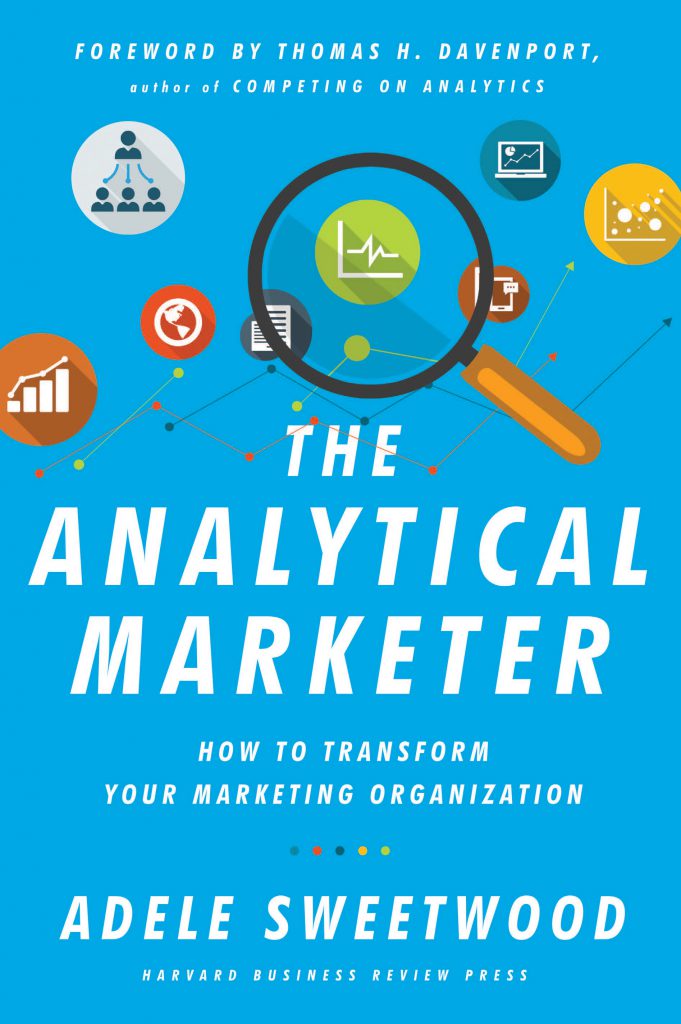Q&A with Adele Sweetwood, author of The Analytical Marketer

 Adele Sweetwood is senior vice president of global marketing and shared services at SAS and author of The Analytical Marketer: How to Transform Your Marketing Organization (HBR Press, 2016). We asked her about her new book and what it means to embrace the life of an analytical marketer.
Adele Sweetwood is senior vice president of global marketing and shared services at SAS and author of The Analytical Marketer: How to Transform Your Marketing Organization (HBR Press, 2016). We asked her about her new book and what it means to embrace the life of an analytical marketer.
Q: What inspired you to write this book?
Adele: This is the book I wish I had when I led the marketing transformation at SAS. I wrote this book to share insights and lessons with others who are also reinventing their marketing organizations for the digital age. It provides a practical account of how to create a new marketing culture that thrives and adds value through data and analytics. While I/we continue to learn and evolve every day, my hope is that I give other marketers the head start I didn’t have by sharing our experiences as we went through the metamorphosis.
Q: Can you tell us a little more about the book? What’s the pitch?
Adele: Analytics are driving big changes, not only in what marketing departments do but in how they are organized, staffed, led and run. Leaders are grappling with issues that range from building an analytically driven marketing organization and determining the kinds of structure and talent that are needed to leading interactions with IT, finance and sales and creating a unified view of the customer. The Analytical Marketer provides critical insight into the changing marketing organization—digital, agile and analytical—and the tools for reinventing it.
While I work for an analytics company, this book is certainly not meant to churn out marketing messages about our software. This book is based on my personal journey of transforming SAS’s marketing organization from “art” to “art and science.” Readers will learn about how our marketing team leveraged data and analytics to market in a new way and the needed technical capabilities of the modern marketer. I open up with some very candid lessons learned and profile various SAS marketers and their stories. The end result is a practical guide and set of best practices for creating a new marketing culture that thrives on and adds value through data and analytics.
Q: How have data and analytics changed marketing?
Adele: Customers expect us to know what they want. They are more informed, engaged and in control than ever before, especially when it comes to marketing and communications. Data and analytics change the expectations placed on marketing. Personalization, digital footprint and the appreciation for privacy put a new set of requirements on marketing. Understanding the value of the data and the power of analytics in terms of interpreting the needs of the customers has changed the way marketers design and implement campaigns, promotions or advocacy programs.
There is an always-on world happening around us, with a huge volume of data and an increasing number of channels (digital, social, etc.) at our fingertips. Data and analytics is part of the survival kit. So, along with the newest opportunities comes the fact that marketers (and marketing) have to reinvent themselves on a regular basis. There is a new type of marketer—the analytical marketer, who effectively blends what is traditionally the creative side of marketing with the scientific side—enhancing the outcome. The biggest change marketing will see from data and analytics are the people.
Q: If you’re a marketing manager trying to hire the right candidates for the modern marketing organization, what should you look for?
Adele: There is a new baseline for all marketers. The skill set includes a knowledge of data management principles and analytical strategies and an understanding of the role of data quality, the importance of data governance and the value of data in marketing disciplines. Today’s marketer needs to go well beyond reporting and metrics, and be more proficient in a full range of analytics, which may include optimization, text, sentiment, scoring, modeling, visualization, forecasting and attribution.
Marketers need to have experience with the technology, tools and design approaches that leverage data and analytics. Campaign design, multi-channel integration, content performance, personalization and digital marketing can all be driven by fact-based decision-making, ideally with direct accountability to results and the ability to very quickly react and adjust to the demands of the customer and the market. The marketers I am referring to have a distinct blend of creativity and reasoning talents; they are inquisitive, inventive and enthused by a culture that is advanced and agile.
Q: In the book you talk about a Best Friend Analysis? What exactly is that?
Adele: Consider the way that sites like Google, Yelp and others have changed the way consumers make everyday decisions such as choosing restaurants. For many, the first instinct is to look to their phone to see which dining spot has the highest ratings or the best reviews. Why? People place a premium on the personal experience of those in their networks.
For business-to-business software companies like SAS, the impact of customer advocacy is critical. These influencers can set the tone and provide a consistent positive influence throughout the customer journey. Unfortunately, this type of advocacy is tough to measure and hard to predict. The BFF analysis looks at how the SAS team found these advocates/influencers by digging into the data that they had on customers. How the team began to examine the behaviors exhibited by that group. How this information provided a better understanding of the range of activities that customers undertake and allowed the team to apply a scoring model for different types of interactions. This would allow the team to weight certain activities, helping further identify which customers are the best advocates—or “BFFs” or “best friends forever” as the marketing team began to call them. The team then designs campaigns and outreach efforts to give these advocates the tools to foster and expand their influence.
Q: Why are analytical marketing tools so critical for today’s marketer?
Adele: Embracing analytical marketing tools and techniques not only give you better results, they also allow you to become more flexible and responsive. The ability to make decisions more quickly, change investment strategies, change channels, adjust volumes and test new approaches means that as an organization you will be more relevant. By making the mindset shift to embrace analytical thinking, you also gain the ability to make adjustments on the fly; you don’t need to wait six months to see whether your campaign was effective or not. The data and analysis will tell you in real time what’s happening—which gives you the opportunity to make changes and tweaks also in real time based on how customers are responding. That’s powerful and empowering across the organization.
Q: Any last thoughts?
Adele: These are no doubt complex times for marketers and I have no doubt that more transformational activities in marketing are coming. I also know that technology, advanced analytics, methodology and a strong analytical culture drive innovation. This is no longer the era of Don Draper, the now infamous lead character in the TV show Mad Men, a creative genius who always seemed to know what kind of campaign the client would fawn over. Enter the era of math men and women, powered by the data and analysis they have at their disposal, leveraging it to inform and guide the right direction, encouraging inquisition and challenging the status quo.
This article originally appeared in the October 2016 issue of Direct Marketing.





No Comment